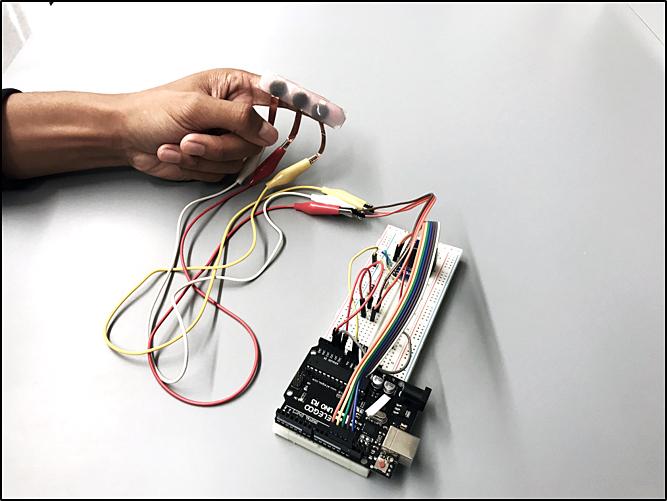Technology designed to advance self-powering devices such as consumer electronics and defense innovations

Credit: Wenzhuo Wu/Purdue University
WEST LAFAYETTE, Ind. – A fascination with movie technology that showed robots perform self-repair through a liquid formula inspired a Purdue University professor to make his own discoveries – which are now helping to lead the way for advancements in self-powering devices such as consumer electronics and defense innovations.
The Purdue team, led by Wenzhuo Wu, the Ravi and Eleanor Talwar Rising Star Assistant Professor of Industrial Engineering, has created wearable technology to convert mechanical energy into electrical energy. A video about the technology is available at https:/
“Our work presents an important step toward the practical realization of self-powered, human-integrated technologies,” Wu said.
The Purdue team invented a liquid-metal-inclusion based triboelectric nanogenerator, called LMI-TENG. Triboelectric energy harvesting transducers – devices which help conserve mechanical energy and turn it into power – are predicted to be a $480 million market by 2028, according to IDTechEx.
The LMI-TENG can harvest and sense the biomechanical signals from the body and use those to help power and direct technological devices. The LMI-TENG consists of a layer of liquid metal embedded functional silicone sandwiched between two Ecoflex layers.
The Purdue technology is featured in the February edition of the Journal of Materials Chemistry A, which named it one of 2019’s HOT papers.
“We realized that liquid represents the ultimate form of anything that can be deformable and morphing into different shapes,” Wu said. “Our technology will enable wearable electronics to take otherwise wasted energy and transform it into energy that can power and control electronic devices and tools used in military defense and consumer applications. Our technology allows the synergistic engineering of TENG components at the material, structural and output levels.”
Wu said the Purdue technology has applications for many self-powered innovations for emerging technologies, such as wearable sensors, pervasive computing, advanced health care, human-machine interfaces, robotics, user interfaces, augmented reality, virtual reality, teleoperation and the Internet of Things.
###
Their work aligns with Purdue’s Giant Leaps celebration, acknowledging the university’s global advancements in artificial intelligence and health as part of Purdue’s 150th anniversary. AI and health are two of the four themes of the yearlong celebration’s Ideas Festival, designed to showcase Purdue as an intellectual center solving real-world issues.
Researchers worked with the Purdue Research Foundation Office of Technology Commercialization to patent the innovation, and they are looking for partners to continue developing it.
About Purdue Research Foundation Office of Technology Commercialization
The Office of Technology Commercialization operates one of the most comprehensive technology transfer programs among leading research universities in the U.S. Services provided by this office support the economic development initiatives of Purdue University and benefit the university’s academic activities. The office is managed by the Purdue Research Foundation, which received the 2016 Innovation and Economic Prosperity Universities Award for Innovation from the Association of Public and Land-grant Universities. For more information about funding and investment opportunities in startups based on a Purdue innovation, contact the Purdue Foundry at [email protected]. For more information on licensing a Purdue innovation, contact the Office of Technology Commercialization at [email protected]. The Purdue Research Foundation is a private, nonprofit foundation created to advance the mission of Purdue University.
Writer: Chris Adam, 765-588-3341, [email protected]
Source: Wenzhuo Wu, [email protected]
Media Contact
Chris Adam
[email protected]
Related Journal Article
http://dx.




